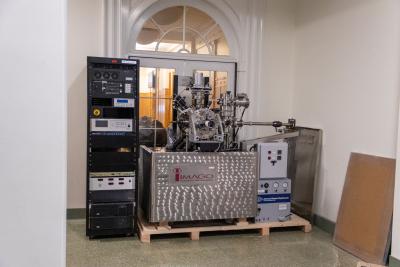The Eberly College of Science has a long history of research and teaching excellence in physics, including notable achievements in atomic-scale research and quantum science.

In 1955, the late Erwin Müller, Evan Pugh Research Professor of Physics, became the first person to “see” the atom, using a field ion microscope that he invented, in Osmond Laboratory on the Penn State University Park campus. Prior to this landmark advance in scientific instrumentation, there was no direct proof of the existence of atoms. Müller’s research group, which included then–graduate student John Panitz, went on to invent the atom-probe field ion microscope, an atomic-resolution microscope that can reveal the chemical identity of individual atoms, in 1967. Panitz has generously donated a variety of equipment and Müller’s research materials to the Eberly College of Science, which are now on display in Müller’s former office and the lobby of Osmond Laboratory.

In 1986, Abhay Ashtekar, Atherton Professor of Physics, developed the theory of loop quantum gravity, which uses quantum mechanics to extend gravitational physics beyond Einstein’s theory of general relativity and opened up a new paradigm in modern physics. As part of this effort, he discovered a new set of variables, now known as Ashtekar variables, that provide a powerful representation of canonical general relativity.
Ashtekar founded the Institute for Gravitation and the Cosmos at Penn State, which investigates the fundamental forces of the universe, including gravity, as a way to explain the origin and evolution of the universe. He also founded and later endowed the popular Ashtekar Frontiers of Science lecture series, which celebrated its 31st season this spring.

In 1988, Jainendra Jain, Evan Pugh University Professor and Erwin W. Müller Professor of Physics and holder of the Eberly Family Chair in Physics, made theoretical advances that reshaped understanding of quantum mechanics. For these “groundbreaking contributions to quantum matter and its topological potential,” he was recognized with the prestigious 2025 Wolf Prize in Physics.
In his early theory research, Jain introduced a class of exotic particles called composite fermions, which helped explain nuances around a phenomenon known as the quantum Hall effect. The quantum Hall effect occurs when electrons in two dimensions are subjected to a strong magnetic field, which results in unique electrical properties. His theory included the intricate sequence of fractional quantum Hall states, now known as Jain states. Jain’s theoretical advances have led to many theoretical and experimental advances, which may ultimately support applications like quantum computing.
Learn more about Jain's scientific advances.

To further support world-class research and education at Penn State, Osmond Laboratory will undergo critical renovations, including a 48,000-square-foot addition. The renovation will feature new, cutting-edge research lab spaces and a high-bay research facility to accommodate large-scale experiments; spaces to facilitate collaboration and connection; and improvements to teaching spaces. According to physics department head Mauricio Terrones, “These updates to the physics department facilities, specifically those for condensed-matter physics and particle astrophysics, will help us continue to attract and retain the best faculty in support of our highly ranked program.”
Learn more about the new physics facility.
